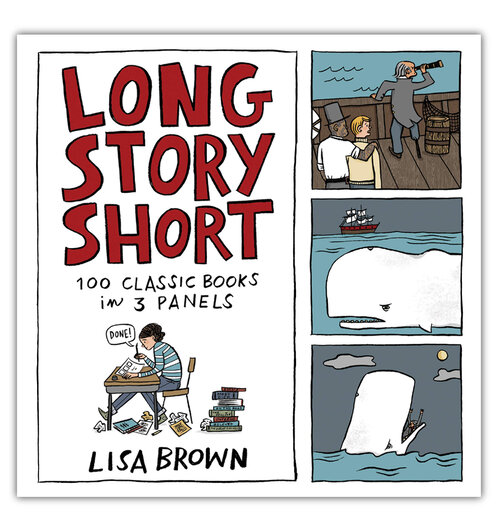Friday, 10 April 2020
(Some of) What a Graphic Novel Can Do by JD DeHart
As someone who frequently reads graphic novels, I am continually impressed with the variety of meaning that creators in this medium convey. In this post, I’ll share about five graphic novels I’ve picked up in the past few weeks, and speak briefly to how they work.
First, I will share about Lisa Brown’s Long Story Short. Brown has recently released a full-length graphic novel, The Phantom Twin, but will soon be publishing Long Story Short. Brown takes classic books and adapts them in three to five panels. It’s witty and engaging work, and Brown’s clever illustrations satirize these works in ways that should be shared. I can’t imagine teaching one of these books without sharing the comic strip as a preview or reinforcement.
I have also had the pleasure of reading both volumes of Strange Fruit by Joel Christian Gill. These books examine history by bringing to the surface “uncelebrated narratives from black history.” The books are highly engaging in the way they work visually, and the content is meaningful and powerful. These books most definitely belong in classroom libraries and tell stories that need to be shared. I am captivated by this idea of telling the story that is sometimes unnoticed.
The books go beyond simple narrative and reach into history, conveying strong stories in compelling and supportive ways, with pictures and texts. Gill then shares a Did You Know? section and bibliographies by the time the end of the books arrives.
In addition to these books, I would further recommend reading A for Anonymous by David Kushner and Koren Shaomi. This book is aimed at a more mature audience, while the books I have shared so far are a little more accessible across a range of ages. Kushner presents the story of the group Anonymous in an eye-catching way, and uses the graphic novel medium to do journalistic work. Can a graphic novel do that? Apparently so.
What stands out most about A for Anonymous is the possibility of the book for stimulating conversation. Kushner, working in true journalistic fashion, presents a narrative with facts, poses questions, and leaves it up to the audience to suss out where they sit with the issues that are shared.
Finally, I will share here about a book that is decidedly less heavy than the ones I have mentioned so far, and yet important. How do readers work up to books like the ones I have shared? A repertoire of lovely and tantalizing books, including graphic novels, can be offered at early ages.
As one example, see the work of Dav Pilkey. As another example, I invite you to consider Wilfrid Lupano, working with Mayana Itoїz and Paul Cauuet, as they present a story that is full of humor and merges the medium of picture book with graphic novel in The Wolf in Underpants Freezes His Buns Off.
The book is colorful and I most appreciated how the author and illustrators combine their efforts to interplay words and pictures in full-page examples, as when a conversation takes place among characters across a shelf that is laden with cheese.
All of these books, in the wide range of how they work, demonstrate a clear variety of the graphic novel medium – and yet only serve at the tip of the iceberg for what can be discovered. Graphic novels and comic books really can do much more than they are sometimes given credit for in the world of reading.


No comments:
Post a Comment
Note: only a member of this blog may post a comment.